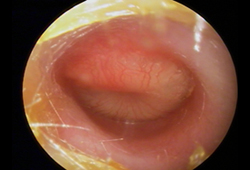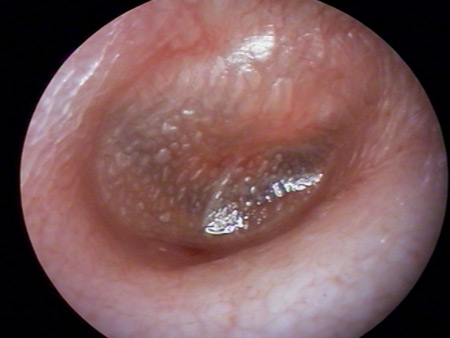Case history
Your Organizational Guidance
ebpracticenet urges you to prioritize the following organizational guidance:
Cliquez ici pour les guides de pratique clinique sur l'otite moyenne aiguë et leur mise en œuvre dans le contexte belgePublished by: ebpracticenet adminLast published: 2024Acute otitis media (NL versie)Published by: ebpracticenet adminLast published: 2024Case history
An 18-month-old toddler presents with 1 week of rhinorrhea, cough, and congestion. Her parents report she is irritable, sleeping restlessly, and not eating well. Overnight she developed a fever. She attends day care and both parents smoke. On examination signs are found consistent with a viral respiratory infection including rhinorrhea and congestion. The toddler appears irritable and apprehensive, and has a fever. Otoscopy reveals a bulging, erythematous tympanic membrane and absent landmarks. [Figure caption and citation for the preceding image starts]: Otoscopy appearance of a bulging, erythematous tympanic membrane and absent landmarksFrom the personal collection of Dr Armengol [Citation ends].
Other presentations
In older (verbal) children and adults the history should include otalgia. Some patients may report decreased hearing or popping sensations on the affected side, nausea, poor appetite, and restless sleep.
As in infants, the examination often reveals signs consistent with a viral respiratory infection including rhinorrhea and congestion. Conventional otoscopy reveals a bulging tympanic membrane, a requirement for the diagnosis.
Occasionally a patient will present with purulent otorrhea, which indicates that the tympanic membrane has ruptured as a result of positive pressure within the middle ear space. [Figure caption and citation for the preceding image starts]: Purulent otorrhea, indicating that the tympanic membrane has rupturedFrom the personal collection of Dr Armengol [Citation ends].
Once the membrane is perforated, many of these patients will cease complaining of otalgia and other symptoms of discomfort. The presence of copious amounts of purulent otorrhea may interfere with the examiner's ability to visualize the ear drum. When visible the tympanic membrane will appear dull and shagrinated (cobblestoning).[Figure caption and citation for the preceding image starts]: Tympanic membrane with shagrinationFrom the personal collection of Dr Armengol [Citation ends].
Use of this content is subject to our disclaimer